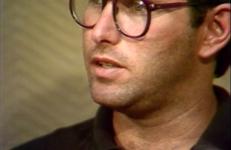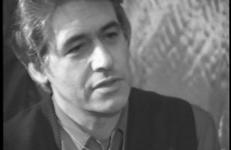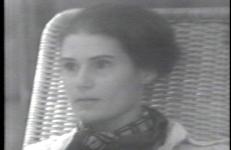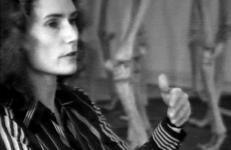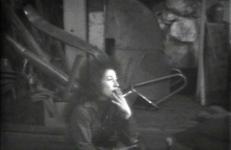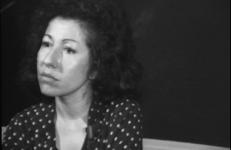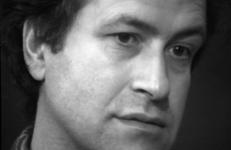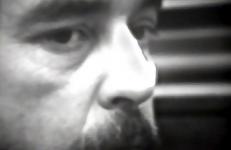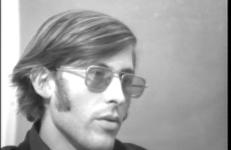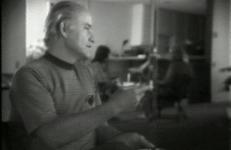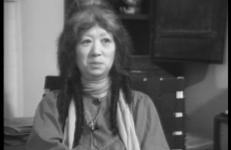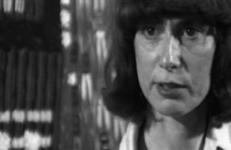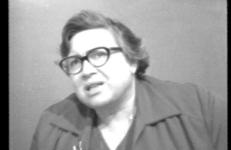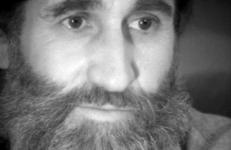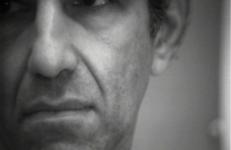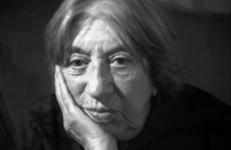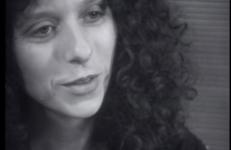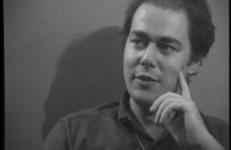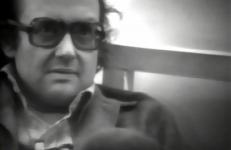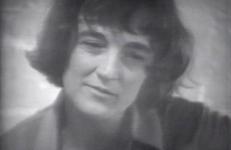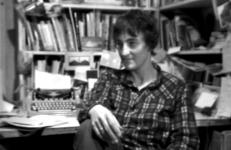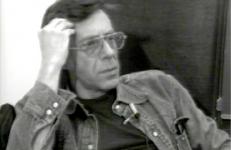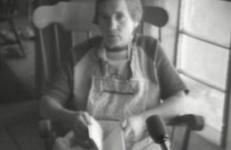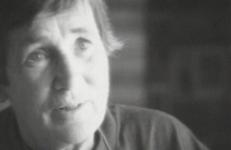Allen Ginsberg (1926-1997) was a leading American poet who gained notoriety in the 1950s and ’60s through his association with the Beat Generation and the San Francisco Renaissance. One of the most controversial poets of his time, his book Howl and Other Poems faced an obscenity trial in 1957 and became one of the most widely read poems of the 20th Century. In the '60s and '70s, Ginsberg studied under gurus and Zen masters.
Blumenthal/Horsfield Interviews
Ron Gorchov (b. 1930) is an American artist who has been working with curved surface paintings and shaped canvases since 1967. He paints on convex/concave saddle-shape canvases with recurring pairs of symmetrical, oar-like images.
Nancy Graves (1939-1995) was a New York sculptor, painter, and filmmaker who used natural history as a reference for dealing with the relationships between time, space, and form. Her work shows the formative influence of the natural sciences, history, art, and cultural studies that she encountered as a child. After majoring in English Literature at Vassar, Graves studied painting at Yale with Jack Tworkov, Alex Katz, and Al Held, among other artists and traveled extensively, spending time in Paris and Florence.
Nancy Graves (1939-1995) was a New York sculptor, painter, and filmmaker who used natural history as a reference for dealing with the relationships between time, space, and form.
In this interview she discusses her transition from a static form (sculpture) to a moving form (film), and finally, to painting. “The making of it and the viewing of it are the areas with which I’m most concerned, because I’m an artist, not a philosopher,” Graves says in this interview with Kate Horsfield.
Best known for her carved wooden heads wrapped in black leather affixed with zippers, glass eyes, enamel noses, spikes and straps, Nancy Grossman (b.1940) is accomplished in draftsmanship, assemblage, and relief sculpture as well as carvings. After growing up on a farm in upstate New York, Grossman went to Pratt, where Richard Lindner’s emphasis on the figure and in the integrity of his personal syntax became an influence. In the 1960s her head sculptures brought her notoriety and five solo exhibitions before the age of thirty.
Best known for her carved wooden heads wrapped in black leather affixed with zippers, glass eyes, enamel noses, spikes and straps, Nancy Grossman (b.1940) is accomplished in draftsmanship, assemblage, and relief sculpture as well as carvings. After growing up on a farm in upstate New York, Grossman went to Pratt, where Richard Lindner’s emphasis on the figure and in the integrity of his personal syntax became an influence.
Conceptual artist Hans Haacke’s two most notorious works took unsavory Manhattan real-estate dealing as their subject, which triggered the cancellation of his exhibition Real Time Social System at the Guggenheim Museum in 1971. With the conscientiousness of an investigative reporter, Haacke continues to scrutinize the rough edges between art and life.
Among the leading pioneers of the eco-art movement, the collaborative team of Newton and Helen Mayer Harrison (often referred to simply as “the Harrisons”) have worked for almost forty years with biologists, ecologists, architects, urban planners and other artists to initiate collaborative dialogues to uncover ideas and solutions which support biodiversity and community development.
Robert Heineken (1931-2006) used technically sophisticated photographic methods to mingle erotic images with visuals from TV and advertising. The American artist was known for appropriating and re-processing images from magazines, product packaging or television. In the "Are You Real" series from 1964 to 1968, he created a portfolio of images filled with unexpected and sometimes surreal juxtapositions by placing a single magazine page on a light table, so that the resulting contact print picks up imagery from both sides of the page.
Douglas Hollis (b.1948) was born in Ann Arbor, Michigan and continued to live there throughout the years of his college education at the University of Michigan. From an early age he had a deep interest in Native American culture. His experiences traveling in Oklahoma to live with Indian families has strongly influenced his life and his art ever since. Hollis began working with natural phenomena and responsive environment structures in the later part of the 1960's. At that time he completed several projects with musicians, dancers, film makers, engineers, and physicists.
Robert Irwin (b. 1928, Long Beach, California) followed in the Abstract Expressionist tradition until he shifted his focus onto installation projects that play upon site-specific uses of light. Since the 1980s, he has created large-scale public space designs that use natural light, plants, and garden architecture.
Miyoko Ito was known as an “abstract surrealist.” Her paintings are landscape-based abstractions of very intense subtleties of structure and color. Ito was born to Japanese parents in Berkeley, CA in 1918. She studied art at the University of California at Berkeley for a short time until she was imprisoned in a Japanese-American camp after the bombing of Pearl Harbor. Ito continued her education in prison, after which she attended Smith College. She was then given a scholarship to attend the School of the Art Institute of Chicago. It was in Chicago that Ito's career as an artist flourished, where she explored cubism and latent abstraction in her works. Ito remained in Chicago until her death in 1983.
Yvonne Jacquette (b.1934)is an American painter and printmaker known in particular for her depictions of aerial landscapes, especially her low-altitude and oblique aerial views of cities or towns, often painted using a distinctive, pointillistic technique. In addition to her paintings, Jacquette frequently collaborated with her late husband, the photographer and filmmaker Rudy Burckhardt, who was also known for his depictions of the urban environment.
Estelle Jussim (1928-2004) was regarded as one of the most influential voices in photography and media. An art historian and a communications theorist, Jussim wrote extensively about photographers, movements, and institutions, incorporating postmodern, deconstructionist, and feminist viewpoints in her many writings without being hemmed in by any one critical ideology. Jussim was the award-winning author of Slave to Beauty and the pioneering Visual Communication and the Graphic Arts, which charted new ground in the investigation of the meaning of images.
In 1958, Allan Kaprow (1927-2006) published an article on Abstract Expressionism entitled The Legacy of Jackson Pollock in which he suggested the separation of the art-making activity from the art itself. Kaprow’s concept was most famously realized through Happenings, during which the traditional role of artist-creator was replaced by what he called “the social occasion.” In these events, divisions between artist and audience—and between the artwork and the perception of it—were dissolved.
American figurative artist Alex Katz (b.1927) has produced a remarkable and impressive body of work but is best known for his large-scale, flat, yet realistic portraits of friends and family notable for their relaxed attitudes and uncomplicated bearing. In the early 1960s, influenced by films, television, and billboard advertising, Katz began painting large-scale paintings, often with dramatically cropped faces.Utilizing characteristically wide brushstrokes, large swathes of color, and refined compositions, Katz created what art historian Robert Storr called "a new and distinctive type
Lee Krasner (1908-1984) was born in New York and attended Cooper Union, the National Academy of Design, and the Hofmann School to study painting. Married to Jackson Pollack, Krasner's own practice was largely overlooked by the art world during her lifetime. She is one of the few women to play a major part in the transition from Modernist painting of the 1930s to the eventual triumph of Abstract Expressionism in the 1950s. Krasner, with Pollack, launched the New York School after World War II.
At nineteen, Barbara Kruger (b. 1945) worked as a commercial artist designing for Conde Nast. The risky combination of contemporary art, commercial appeal and social critique runs throughout Kruger’s photography, readings, poetry, collages, and conversation. Her works uses advertising both as a foil and a format. Language and image work together, referencing the manipulations of the advertising media.
Scottish artist Thomas Lawson (b. 1951) is a painter, critic, and founding editor of REAL LIFE magazine who lives and works in Los Angeles. His paintings are tied to the particularities of the present, and he is especially critical of the art world’s infatuation with ego and creativity. His portraits, appropriated from the print media, represent an intervention in that vein.
American, minimalist painter Sol Lewitt (1928-2007) used the grid as a foundation for his many artworks. Seeing himself in the role of architect or composer, Lewitt was most concerned with the concept behind the piece rather than the final product. His geometrical compositions stripped away extraneous information and presented the bare essentials.
Lucy Lippard (b. 1937) earned degrees from Smith College and New York University before beginning her career as an art critic in 1962, when she began contributing to publications such as Art International and later, Artforum. In 1966, she organized an exhibition entitled Eccentric Abstraction at the Fischbach Gallery in New York City.
Lucy Lippard (b. 1937) earned degrees from Smith College and New York University before beginning her career as an art critic in 1962, when she began contributing to publications such as Art International and, later, Artforum. In 1966, she organized an exhibition entitled “Eccentric Abstraction” at the Fischbach Gallery in New York City. “Eccentric Abstraction” set the standard for what would later be regarded as postminimalism, process, or antiform art.
Nathan Lyons (b.1930) has contributed to the field of photography as a critic, author, curator, educator, and photographer. He has published several books and catalogs, including Photographers on Photography (1966), Photography in the 20th Century (1967), Towards a Social Landscape (1967), Persistence of Vision (1968), and Notations in Passing (1974). His body of work consists primarily of photographs which focus on American culture.
Originally from Canada, Agnes Martin (1912-2004) moved to the U.S. in 1931. Martin lived in Taos, New Mexico from 1954 to 1957, and then moved to New York, where she established her name as an important minimalist painter.
Originally from Canada, Agnes Martin (1912-2004) moved to the U.S. in 1931. Martin lived in Taos, New Mexico from 1954 to 1957 and then moved to New York, where she established her name as an important minimalist painter. Her work differed conceptually from the minimalist movement in that it was anti-intellectual and intensely spiritual, and her grids represented meditative reflections on Taoism.




